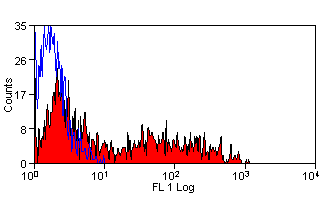MHC Class II DQ antibody | 2C4


Mouse anti Rabbit MHC Class II DQ
- Product Type
- Monoclonal Antibody
- Clone
- 2C4
- Isotype
- IgG2a
- Specificity
- MHC Class II DQ
| Mouse anti Rabbit MHC class II monoclonal antibody, clone 2C4 recognizes the class II RLA-DQ molecule. The major histocompatibility complex (MHC) is a cluster of genes that are important in the immune response to infections. In rabbits, this complex is referred to as the rabbit leukocyte antigen (RLA) region. There are 3 major MHC class II proteins encoded by the RLA which are RLA DP, RLA DQ and RLA DR. Mouse anti rabbit MHC class II recognizes the RLA DQ molecule, expressed by antigen presenting cells, B cells and monocytes. Mouse anti rabbit MHC class II monoclonal antibody, clone 2C4 is able to significantly inhibit the mixed lymphocyte reaction. Immunoprecipitation with the antibody yields three bands of molecular weights 28, 31 and 35 kDa. |
- Target Species
- Rabbit
- Product Form
- Purified IgG - liquid
- Preparation
- Purified IgG prepared by affinity chromatography on Protein A from tissue culture supernatant
- Buffer Solution
- Phosphate buffered saline
- Preservative Stabilisers
- 0.09% Sodium Azide (NaN3)
- Carrier Free
- Yes
- Immunogen
- Rabbit spleen cells
- Approx. Protein Concentrations
- IgG concentration 1.0 mg/ml
- Fusion Partners
- Spleen cells from immunised mice were fused with cells of the P3.X63. Ag8.653 mouse myeloma cell line
- Regulatory
- For research purposes only
- Guarantee
- 12 months from date of despatch
Avoid repeated freezing and thawing as this may denature the antibody. Storage in frost-free freezers is not recommended.
| Application Name | Verified | Min Dilution | Max Dilution |
|---|---|---|---|
| Flow Cytometry | 1/25 | 1/200 | |
| Immunohistology - Frozen | |||
| Immunoprecipitation |
- Flow Cytometry
- Use 10ul of the suggested working dilution to label 106 cells or 100ul whole blood
| Description | Product Code | Applications | Pack Size | List Price | Your Price | Quantity | |
|---|---|---|---|---|---|---|---|
| Goat anti Mouse IgG (H/L):FITC (Multi Species Adsorbed) | STAR117F | F | 0.5 mg |
|
Log in | ||
| List Price | Your Price | ||||||
|
|
Log in | ||||||
| Description | Goat anti Mouse IgG (H/L):FITC (Multi Species Adsorbed) | ||||||
| Rabbit F(ab')2 anti Mouse IgG:RPE | STAR12A | F | 1 ml |
|
Log in | ||
| List Price | Your Price | ||||||
|
|
Log in | ||||||
| Description | Rabbit F(ab')2 anti Mouse IgG:RPE | ||||||
| Rabbit F(ab')2 anti Mouse IgG:HRP (Human Adsorbed) | STAR13B | C E P RE WB | 1 mg |
|
Log in | ||
| List Price | Your Price | ||||||
|
|
Log in | ||||||
| Description | Rabbit F(ab')2 anti Mouse IgG:HRP (Human Adsorbed) | ||||||
| Rabbit F(ab')2 anti Mouse IgG:FITC | STAR9B | F | 1 mg |
|
Log in | ||
| List Price | Your Price | ||||||
|
|
Log in | ||||||
| Description | Rabbit F(ab')2 anti Mouse IgG:FITC | ||||||
| Description | Product Code | Applications | Pack Size | List Price | Your Price | Quantity | |
|---|---|---|---|---|---|---|---|
| Mouse IgG2a Negative Control | MCA929 | F | 100 Tests |
|
Log in | ||
| List Price | Your Price | ||||||
|
|
Log in | ||||||
| Description | Mouse IgG2a Negative Control | ||||||
Source Reference
-
Lobel, S.A. et al. (1984) The role of rabbit Ia molecules in immune functions as determined with the use of an anti-Ia monoclonal antibody.
Immunology 51: 35-43.
References for MHC Class II DQ antibody
-
Spieker-Polet, H. et al. (1990) Rabbit major histocompatibility complex. IV. Expression of major histocompatibility complex class II genes.
J Immunogenet. 17 (1-2): 123-32. -
Wilkinson, J.M. et al. (1992) A cytotoxic rabbit T-cell line infected with a gamma-herpes virus which expresses CD8 and class II antigens.
Immunology 77: 106-8. -
Idogawa, H. et al. (1997) Progression of articular destruction and the production of tumour necrosis factor-alpha in antigen-induced arthritis in rabbits.
Scand J Immunol. 46: 572-80. -
Andersen, H.O. et al. (1999) Effect of cyclosporine on arterial balloon injury lesions in cholesterol-clamped rabbits: T lymphocyte-mediated immune responses not involved in balloon injury-induced neointimal proliferation.
Arterioscler Thromb Vasc Biol. 19: 1687-94. -
Matsumura, T. et al. (1999) Suppression of atherosclerotic development in Watanabe heritable hyperlipidemic rabbits treated with an oral antiallergic drug, tranilast.
Circulation 99 (7): 919-24. -
Alt, C. et al. (2009) Increased CCL2 expression and macrophage/monocyte migration during microbicide-induced vaginal irritation.
Curr HIV Res. 7: 639-49. -
Yuan, T. et al. (2010) Chondrogenic differentiation and immunological properties of mesenchymal stem cells in collagen type I hydrogel.
Biotechnol Prog. 26 (6): 1749-58. -
Shen, W. et al. (2013) Osteoarthritis prevention through meniscal regeneration induced by intra-articular injection of meniscus stem cells.
Stem Cells Dev. 22 (14): 2071-82.
View The Latest Product References
-
Sun, F. et al. (2023) Biomimetic in situ tracheal microvascularization for segmental tracheal reconstruction in one-step.
Bioeng Transl Med. 8 (4): e10534.
MCA811GA
If you cannot find the batch/lot you are looking for please contact our technical support team for assistance.
Please Note: All Products are "FOR RESEARCH PURPOSES ONLY"
View all Anti-Rabbit ProductsAlways be the first to know.
When we launch new products and resources to help you achieve more in the lab.
Yes, sign me up
